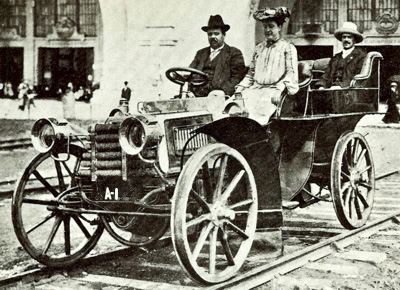The History and Evolution of UK Number Plates
Number plates, an essential component of road vehicles, hold a significant place in the history of transportation in the United Kingdom. From their humble beginnings in the early 20th century to the modern-day personalised plates, they serve not only as identification markers but also as a reflection of personal identity and style. In this article, we delve into the intriguing journey of UK number plates, exploring their origins, evolution, and current significance.
The Origins of Number Plates
This pivotal legislation heralded a new era in road regulation, mandating the registration of all vehicles. The introduction of number plates marked a significant stride forward in enhancing road safety and accountability.
During their nascent stages, number plates were characterised by a straightforward format—a concise one- or two-letter code followed by a sequential number. This simplistic yet effective system facilitated the identification of vehicles by authorities and laid the foundation for subsequent developments in vehicle registration.
 Among the earliest and most renowned number plates are those bearing designations like A 1, Y 1, and DY 1. These plates, steeped in historical significance, serve as tangible reminders of the dawn of motoring in the UK. Revered by collectors and enthusiasts alike, they evoke a sense of nostalgia for a bygone era characterised by pioneering automotive feats.
Among the earliest and most renowned number plates are those bearing designations like A 1, Y 1, and DY 1. These plates, steeped in historical significance, serve as tangible reminders of the dawn of motoring in the UK. Revered by collectors and enthusiasts alike, they evoke a sense of nostalgia for a bygone era characterised by pioneering automotive feats.
The advent of number plates represented a watershed moment in the history of transportation, heralding a paradigm shift towards standardised vehicle registration and accountability on the roads.
The Evolution of Number Plates
As the number of vehicles traversing UK roads surged, the necessity for a more intricate registration system became apparent. This prompted the implementation of various formats and identification mechanisms to accommodate the escalating demand. In response, the suffix system emerged in 1963, which entailed assigning a letter indicative of the registration year, followed by a sequential number. This chronological representation aimed to streamline the registration process, facilitating the efficient tracking of vehicles.
Following this trajectory, the prefix system was ushered in come 1983. In a departure from its predecessor, this system inverted the order, positioning the year identifier at the commencement of the registration sequence. By doing so, it sought to enhance clarity and organisation in the registration process, ensuring seamless management of vehicle records.
However, it wasn’t until the dawn of the new millennium, in 2001, that a transformative shift transpired with the advent of the current4 system. This modernised framework revolutionised vehicle registration by introducing a novel configuration. Under this scheme, vehicles are distinguished by a combination of two letters, signifying the local memory tag, followed by two numerical digits denoting the registration year, and culminating in three random letters. This innovative approach not only confers a unique identifier upon each vehicle but also offers an expansive array of personalisation and customisation options.
Moreover, the current4 system not only caters to the functional aspect of vehicle registration but also encapsulates a sense of individuality and personal expression. This amalgamation of practicality and personalisation underscores the evolution of number plates in the UK, epitomising the dynamic interplay between tradition and innovation.
The Current Formats and Significance of Number Plates
In today’s world, number plates play a vital role on UK roads. They serve as essential identifiers for vehicles, offering valuable information to both authorities and fellow road users. Understanding the elements of the current number plate format can provide insights into a vehicle’s history and origin.
The age identifier on number plates comprises two numbers, indicating the year of registration. This simple feature allows anyone to quickly determine the approximate age of a vehicle. For instance, a number plate with the identifier “21” suggests that the car was registered in the year 2021. This clarity helps in assessing the vehicle’s condition and lifespan, especially when considering purchases or sales.

In addition to standard number plates, personalised or private plates have gained popularity among drivers. These customised plates feature names, initials, or special words chosen by the vehicle owner. By personalising their number plates, individuals can add a unique touch to their vehicles, expressing their personality and individuality on the road. Private plates can be obtained from specialised agencies or directly from the Driver and Vehicle Licensing Agency (DVLA), providing drivers with ample options to customise their cars according to their preferences.
However, it is crucial to adhere to regulations and guidelines when acquiring personalised number plates. Number plates must meet specific requirements regarding size, colour, font, and symbols to ensure visibility and readability. Failure to comply with these regulations can lead to fines, penalties, or even the invalidation of insurance policies. Therefore, while personalising number plates can be an exciting way to make a vehicle stand out, it is essential to do so within the boundaries of the law.
In summary, number plates are more than just combinations of numbers and letters. They serve as important identifiers on UK roads, conveying valuable information about a vehicle’s age and origin. Whether standard or personalised, number plates play a significant role in reflecting the individuality and style preferences of vehicle owners. However, it is crucial to respect the rules and regulations governing number plate design to ensure compliance and road safety for all users.
Finally
The history and evolution of UK number plates reflect the changing landscape of transportation and society as a whole. From their humble beginnings as simple identification markers to the modern-day personalised plates, they continue to play a vital role in road safety, regulation, and personal expression. As we look towards the future, it’s clear that number plates will remain an integral part of the UK’s motoring culture, serving as both a practical necessity and a cherished form of self-expression.

 100% Road Legal
100% Road Legal Express Delivery
Express Delivery